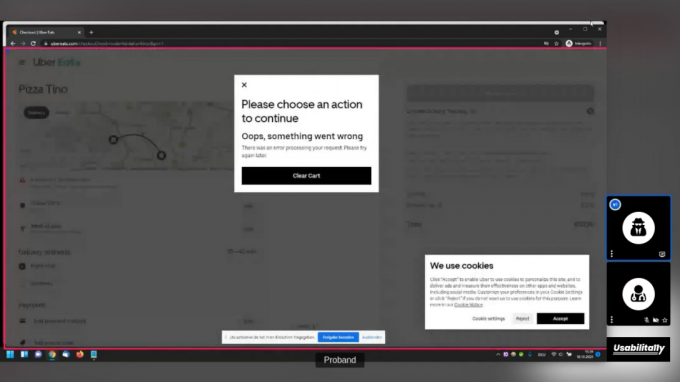At the Gesellschaft zur Entwicklung von Dingen, we often cook for ourselves, but sometimes we are typical nerds and fancy a classic pizza.
Just have a salami pizza delivered? One-fix-three? That would be nice!
Unfortunately, this is still an unfulfilled wish for hundreds of thousands of Germans in 2021.
We tested five well-known delivery services and had our blind colleague check them for user-friendliness and accessibility. The shocking result: he would have starved to death with three providers! Because at some point during the ordering process, he failed due to simple form fields.
But the other two delivery platforms that we tested also had clear deficits in terms of usability: there were so many hurdles to overcome on the way to a full plate that the ordering procedure took between twenty and forty minutes - and left him in a grumbling mood in addition to a growling stomach.

Bildschirmfoto aus einer Aufzeichnung mit englischsprachiger Fehlermeldung "Something went wrong" und einer Schaltfläche zum Leeren des Warenkorbs
Screenshot Usabilitally-Sitzung Ubereats.com
Are blind people not a target group?
People with visual impairments in particular would benefit from the convenience of being able to quickly and easily receive ready-prepared meals at the door at any time. However, the prerequisite for this is that the service providers' websites are barrier-free and do not thoughtlessly exclude population groups that are far too often disadvantaged anyway. Otherwise, the arduous walk to the restaurant two streets away may be less difficult and tedious than the cumbersome trial and error with poorly labelled form fields on the PC. Not to mention cooking for yourself ...
Delivery services put to the test
- lieferando.de – see Recording of the Lieferando test
- foodpanda.de – see Recording of the foodpanda test
- call-a-pizza.de – see Recording of the Call-a-Pizza test
- wolt.com – see Recording of the Wolt test
- ubereats.com – see Recording of the UberEats tests
Unfortunately, the Call a Pizza, Uber Eats and Wolt platforms denied screen reader users the opportunity to order a food delivery purely for technical reasons.
The most common problems
Fortunately, most delivery services have kept the path to selecting the desired dish easily accessible. For some, however, we would like to see better structuring with headings, as most screen reader users navigate mainly via the headings.
The hurdles mainly start when ordering: poor labelling of form elements, lack of feedback when buttons are pressed, laborious finding of the shopping basket, switching to English as soon as elements are invisibly labelled - and repeated pop-ups that are not accessible for assistive technologies.
Test scenario
Thinking Aloud is a common user test method used to detect problems when using a web application, for example, by speaking out loud and recording thoughts and sensations while performing a task. These tests are usually only carried out with sighted test subjects.
In our usability tests, the test subjects use assistive technologies. Team members are present via digital conference and record the Thinking-Aloud protocols. The audio video file and a written evaluation show the individual stumbling blocks of the website. Incidentally, the name Usabilitally is a contraction of usability and accessibility with the common abbreviation A11y.
To get an idea of how to work with a laptop without sight, what aids are available and what the most common obstacles are for them on the World Wide Web, we recommend our blog posts How blind people use computers and Barriers to internet use.
About us
The Gesellschaft zur Entwicklung von Dingen realises solutions for digital sovereignty using open source software. The guiding principles of its work are sustainability and system security, accessibility and data protection. By specialising in different business areas, the company has a broad and versatile base. Typical for the team members: they think outside the box and ask smart questions.
In addition to usability tests, the Broken Image division also offers classic accessibility tests, e.g. expert reports in accordance with BITV or WCAG, as well as the creation and monitoring of accessibility statements. And advice on how to do it better and support with implementation - that is of course also offered.
Gesellschaft zur Entwicklung von Dingen, Osloer Straße 17, D-13359 Berlin
Press contact and material: www.gzevd.de/press
